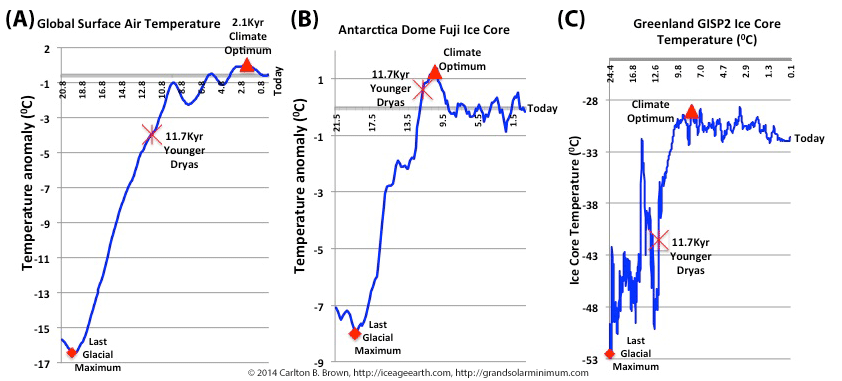Reconstructed global,[i] Antarctic,[ii] and Arctic[iii] glacial cycle temperatures from the last glacial maximum or end of the last ice age (lowest temperature, red diamond shape) to just past the climate optimum at the end of the interglacial period (highest temperature) delineate three points of reference i.e., the last glacial maximum, the end of the Younger Dryas 11,700 years ago, and the Holocene Climate Optimum (red triangle shape). The glacial maxima and the climate optima are at either end of the interglacial period. The supposed end of the last ice age 11,700 years ago (11.7 kiloyear) is marked above. If the ice age ended 11,700 years ago then the 11.7 kiloyear marker should be close to the glacial maximum marker at the bottom of the graphics, but this is not the case.
This data clearly demonstrates that the last ice age ended at the glacial maximum, between 19,300 (Antarctica) and 24,000 years ago (Arctic). The Younger Dryas ended 11,700 years ago. In the intervening 8,000–12,000 years between the glacial maximum and the end of the Younger Dryas, when the current Holocene interglacial had “officially” started (as we are told), nearly two-thirds of the Holocene’s total sea level rise, and three-quarters of the Holocene’s total temperature rise had already taken place. Therefore, equating the end of the Younger Dryas with the end of the last ice age means we are in error as to the correct stage of the glacial cycle that we are in now.
In reality, the Younger Dryas represented the worst rapid climate change event since the last glacial maximum. Prior to the end of the Younger Dryas 11,700 years ago, and within the space of a few decades, the temperature in the Arctic dropped by about nine degrees Celsius.[iv] The temperature did not recover for another three hundred years. During this time the Arctic ice sheets advanced and the most pronounced fauna extinctions of the Holocene interglacial took place, including dozens of mammalian and avian species.[v],[vi]
Click on this page and download a free copy of my book “Revolution: Ice Age Re-Entry,” and read more about this topic in Chapter 3.
[i] R. Bintanja and R.S.W. van de Wal, “North American ice-sheet dynamics and the onset of 100,000-year glacial cycles.” Nature, Volume 454, 869-872, 14 August 2008. doi:10.1038/nature07158. National Centers for Environmental Information, NESDIS, NOAA, U.S. Department of Commerce. Global 3Ma Temperature, Sea Level, and Ice Volume Reconstructions. https://www.ncdc.noaa.gov/paleo-search/study/11933. Downloaded 10/27/2015.
[ii] R.V. Uemura et al., 2012, “Ranges of moisture-source temperature estimated from Antarctic ice cores stable isotope records over glacial-interglacial cycles.” Climate of the Past, 8, 1109-1125. doi: 10.5194/cp-8-1109-2012. National Centers for Environmental Information, NESDIS, NOAA, U.S. Department of Commerce. Dome Fuji 360KYr Stable Isotope Data and Temperature Reconstruction. https://www.ncdc.noaa.gov/paleo-search/study/13121. Downloaded 05/05/2018.
[iii] R.B. Alley., 2004, “GISP2 Ice Core Temperature and Accumulation Data.” National Centers for Environmental Information, NESDIS, NOAA, U.S. Department of Commerce. https://www.ncdc.noaa.gov/paleo/study/2475. Downloaded 05/05/2018.
[iv] A.E. Carlson, 2013, “The Younger Dryas Climate Event.” In: Elias S.A. (ed.) The Encyclopedia of Quaternary Science, Volume 3, 126-134. Amsterdam: Elsevier. http://people.oregonstate.edu/~carlsand/carlson_encyclopedia_Quat_2013_YD.pdf.
[v] Anthony D. Barnosky et al., “Approaching a state shift in Earth’s biosphere.” Nature Volume 486, 52–58 (07 June 2012). doi:10.1038/nature11018. .
[vi] R. B. Firestone et al., “Evidence for an extraterrestrial impact 12,900 years ago that contributed to the megafaunal extinctions and the Younger Dryas cooling.” PNAS October 9, 2007. 104 (41) 16016-16021; https://doi.org/10.1073/pnas.0706977104.

